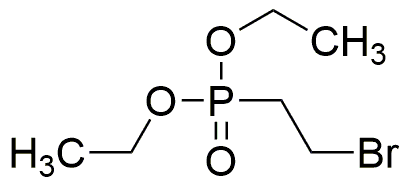Diethyl 2-bromoethylphosphonate is widely utilized in research focused on:
- Synthesis of Organophosphorus Compounds: This chemical serves as a key intermediate in the production of various organophosphorus compounds, which are important in agriculture as pesticides and herbicides.
- Pharmaceutical Development: It is used in the synthesis of pharmaceutical agents, particularly in developing drugs that target neurological disorders, due to its ability to modify biological pathways.
- Research in Chemical Biology: The compound is employed in studies exploring enzyme inhibition and protein interactions, providing insights into biochemical processes and potential therapeutic targets.
- Material Science: It finds applications in creating specialty polymers and materials with enhanced properties, such as flame retardancy and chemical resistance, beneficial for various industrial applications.
- Analytical Chemistry: Diethyl 2-bromoethylphosphonate is utilized as a reagent in analytical methods to detect and quantify phosphorous-containing compounds, aiding in environmental monitoring and quality control.
General Information
Properties
Safety and Regulations
Applications
Diethyl 2-bromoethylphosphonate is widely utilized in research focused on:
- Synthesis of Organophosphorus Compounds: This chemical serves as a key intermediate in the production of various organophosphorus compounds, which are important in agriculture as pesticides and herbicides.
- Pharmaceutical Development: It is used in the synthesis of pharmaceutical agents, particularly in developing drugs that target neurological disorders, due to its ability to modify biological pathways.
- Research in Chemical Biology: The compound is employed in studies exploring enzyme inhibition and protein interactions, providing insights into biochemical processes and potential therapeutic targets.
- Material Science: It finds applications in creating specialty polymers and materials with enhanced properties, such as flame retardancy and chemical resistance, beneficial for various industrial applications.
- Analytical Chemistry: Diethyl 2-bromoethylphosphonate is utilized as a reagent in analytical methods to detect and quantify phosphorous-containing compounds, aiding in environmental monitoring and quality control.
Documents
Safety Data Sheets (SDS)
The SDS provides comprehensive safety information on handling, storage, and disposal of the product.
Product Specification (PS)
The PS provides a comprehensive breakdown of the product’s properties, including chemical composition, physical state, purity, and storage requirements. It also details acceptable quality ranges and the product's intended applications.
Certificates of Analysis (COA)
Search for Certificates of Analysis (COA) by entering the products Lot Number. Lot and Batch Numbers can be found on a product’s label following the words ‘Lot’ or ‘Batch’.
Numéro de catalogue
Numéro de lot/série
Certificates Of Origin (COO)
This COO confirms the country where the product was manufactured, and also details the materials and components used in it and whether it is derived from natural, synthetic, or other specific sources. This certificate may be required for customs, trade, and regulatory compliance.
Numéro de catalogue
Numéro de lot/série
Safety Data Sheets (SDS)
The SDS provides comprehensive safety information on handling, storage, and disposal of the product.
DownloadProduct Specification (PS)
The PS provides a comprehensive breakdown of the product’s properties, including chemical composition, physical state, purity, and storage requirements. It also details acceptable quality ranges and the product's intended applications.
DownloadCertificates of Analysis (COA)
Search for Certificates of Analysis (COA) by entering the products Lot Number. Lot and Batch Numbers can be found on a product’s label following the words ‘Lot’ or ‘Batch’.
Numéro de catalogue
Numéro de lot/série
Certificates Of Origin (COO)
This COO confirms the country where the product was manufactured, and also details the materials and components used in it and whether it is derived from natural, synthetic, or other specific sources. This certificate may be required for customs, trade, and regulatory compliance.


